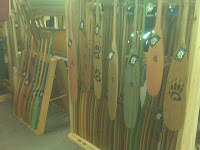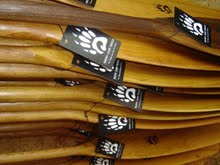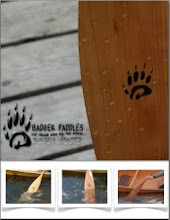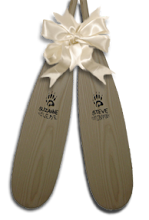Traditional Varnishing Tips Poppa Badger Taught Us:
Let's face it, traditional marine varnish can be nasty toxic stuff plus you need other chemicals to clean up afterwards (like Mineral Spirits, Varsol or Laquer Thinners). But it is still possible to approach the job of varnishing in an economical and environmentally responsible and friendly manner.
It's all in the Bristle
Let's start with the brush. Natural bristle creates a smoother finish then synthetic brushes and are easy to clean. Try to use a brush that's made of wood (handle) and natural bristle. Badger uses brushes that are similar to Lee Valley's. There are more expensive brushes available, but these are very economical. You can always buy a better quality brush, but if so, we highly recommend you are diligent in your cleaning process.
 |
| Natural bristle brushes are strongly recommended. |
While some may like the ease of a sponge or foam brush, it's really only a one-use type of item when using for varnishing. In fact, sometimes, especially with the cheaper ones, the sponge/foam will split and fall apart before the job is even done. Usually, for the price of the foam brush, you are actually using more value in thinners for the cleaning (if you planning to reuse it). Besides, that's a lot of plastic and man-made sponge being thrown into the landfill for only one job! If you want to use a foam brush, try to find one with a wooden handle so it will eventually be able to breakdown in the landfill.
 |
| Try not to purchase plastics if possible. |
Remember, with a natural, and most importantly, re-usable brush, you are able to varnish many paddles and gunwales/gunnels over the course of many different seasons. The only real key to maintaining your brush is Poppa Badger's 4 step clean up!
Badger's 4 Step Brush Clean Up
- Remove excess varnish from brush
- Wash brush in old or dirty spirits/Varsol
- Wash brush in new/clean spirits/Varsol
- Wash brush with soap and water
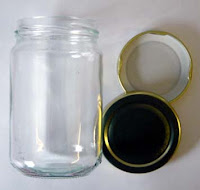 |
| Save your old jars for your "Old Spirits" and Varnish |
This is about using quantities sparingly and then re-using them. The best way to clean a brush after varnishing is to first remove any excess varnish by gently wiping the bristles on rim of your varnish jar*. Next, use some old spirits or Varsol that has been been saved from a previous job. Make sure you don't use too much. You don't want the spirits to rise up over the ferrule (metal part) of the brush. Just cover the bristles.
What is "Old or Dirty Varsol"?
This is the Varsol that was saved (in a sealed jar) from the last time you cleaned your brush after varnishing. This Varsol is dirty looking (in that it is not clear) and may have sediment that has settled at the bottom of the jar* over time. Pour this "old Varsol" into another new and clean open jar*, leaving the sediment at the bottom of the old one. Use the poured off spirits/Varsol to clean your brush by dipping and swishing your brush in the old (poured off) spirits/Varsol. This will be the first wash. Try to remove excess with a shake or two.
 |
| Use clean spirits before washing with soap & water |
After you shake the excess spirits or Varsol off the brush, you are left with the last wash. Your last step will be to use water and a mild soap (preferably an actual brush soap) and wash the brush bristles gently, with your fingers. We have found that dishwashing soap works quite well if no brush soap is available. Rinse with more water until all soap is removed, very gently squeeze out the excess water, and then set the brush flat to dry. And, you are done! As an added tip, Poppa Badger says if you are storing your brush for a long period of time, take a pea to penny-sized amount of raw linseed oil and work it in thru the bristles. You will be amazed at how soft and pliable your brush is the next time you need it.
More Badger's Tips & Tricks
- Don't dip your brush right into your store bought tin of varnish. That will only add dust and other particles to your varnish and contaminate it. Instead, keep your main varnish supply clean and only pour out what you think you will need (pour sparingly - you can always add more if you need it) into another clean and open jar to use for your project.
- Do use the tip of the brush (NOT your finger) to try to catch and remove a stray hair (or other particles) in the varnish as you brush it on. It will prove much easier then using only your fingers!
- Don't put the lid on your varnish if you have too much air between the varnish and the lid of the container. This will cause the varnish to "skin over". Air space is your enemy. Instead, pour the varnish into smaller jars* and continue the process, always pouring your varnish into a smaller container as you use it up - and your varnish will stay much fresher - but you must always lessen the amount of air space in your jar. Works with paint too. If you don't have a proper sized jar, then pour a tiny amount of spirits on top of your varnish to create a "seal". Use only a small layer to cover and when you are ready to use the varnish, just mix in the spirits with your varnish and proceed as usual. (Note: the spirits/Varsol will act as a thinner when using this process so be careful to use only a minimal amount).
- Do give the varnish something to adhere to and lightly scuff or sand with a very fine (320 grit) sand paper between coats. Use a stearated (self-lubricated) sandpaper or use water with a wet proof paper. And do make sure to remove dust before applying the next coat of varnish (with a tack cloth/rag).
- Don't use your "old Varsol or Spirits" to clean a brush that has been used to "paint" with and then try to use it to clean your brush for varnishing. Try to keep a separate jar of "old spirits" for "paint" brush clean ups.
- Do remember - dust will always settle on varnish as it dries. So always make sure your work area is as clean as possible and try to stay away from the project area as the varnish dries so as to NOT stir up any extra dust.
- Don't worry about brushing with or against the grain, except for your last strokes of that coat when you should go WITH the grain.
- Do make sure to dispose of all rags, tins and jars, according to your local municipality's by-laws and regulations, keeping in mind that these materials are highly flammable and could even be susceptible to spontaneous combustion.
- Don't dirty a brush for a quick touch up for a small area. A balled up piece of nylon pantyhose works well as a applicator. Give it a try for small scratches, etc., then dispose of accordingly.
- Do pay attention to the temperature you are working in. If it is too warm, the varnish will dry too quickly and could bubble. If it is too cold, damp, or rainy, the drying process could be also be affected and considerably slowed. Check your manufacture's directions so as to be aware of the optimal temperature range when working with the product of your choice.
For tips on how to maintain your oiled or varnished paddles and/or gunnels/gunwales, visit our website and/or see our maintenance tips on Badger's Blog.... and always make sure to follow the manufacturer's instructions of any product you use.



